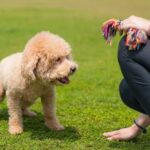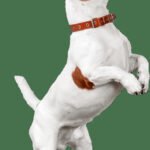Dogs chewing on things can be a frustrating and destructive behavior that many owners face. This article will explore the issue of dog chewing behavior and provide strategies to train dogs not to chew on inappropriate items.
Addressing this behavior is crucial for creating a peaceful and harmonious living environment for both the owner and the dog. By understanding the root causes of dog chewing, managing teething phases, providing mental stimulation, implementing positive reinforcement training, creating dog-friendly environments, addressing separation anxiety, and seeking professional help when necessary, owners can enjoy a chew-free life with their furry companions.
Understanding the Root Causes of Dog Chewing Behavior
Chewing is a natural behavior for dogs, but when it becomes destructive and targets valuable items in your home, it can be frustrating and costly. To effectively address this issue, it is important to understand the root causes of dog chewing behavior. By pinpointing the underlying reasons why dogs engage in chewing, you can implement appropriate strategies to manage and redirect their behavior.
There are several reasons why dogs may chew on objects. One common cause is teething, especially in puppies. During this phase, their gums may become sore and chewing provides relief. It’s crucial to provide suitable chewing alternatives for puppies during teething to prevent them from using your belongings as substitutes.
Boredom and lack of mental stimulation are also common triggers for destructive chewing. Dogs have a lot of energy that needs to be channeled into appropriate outlets. When they don’t have enough physical or mental stimulation, they may resort to chewing as a way to occupy themselves. Providing engaging activities like puzzle toys or interactive games can help keep their minds occupied and prevent them from seeking out forbidden items.
In addition to teething and boredom, anxiety and lack of proper training can also contribute to destructive chewing behavior in dogs. Anxiety often manifests as repetitive behaviors like pacing or excessive barking, but it can also lead to destructive behaviors such as chewing. Proper training and socialization from an early age can help dogs develop better coping mechanisms for dealing with anxiety.
By understanding these root causes, you can begin implementing appropriate strategies to address your dog’s chewing behavior. Providing suitable alternatives for them to chew on, ensuring they receive adequate mental stimulation, and addressing any underlying anxiety or training issues will go a long way in preventing destructive chewing habits.
| Root Causes | Description |
|---|---|
| Teething | Puppies chew to relieve sore gums during the teething phase. |
| Boredom | Dogs may chew when they are not adequately stimulated mentally or physically. |
| Anxiety | Anxious dogs may resort to chewing as a coping mechanism. |
| Lack of Proper Training | Insufficient training can contribute to destructive chewing habits in dogs. |
Puppy Teething
During the teething phase, puppies experience discomfort in their gums as new teeth emerge. This can lead to increased chewing behavior as a way for them to alleviate the pain. To manage chewing during this phase, it is important to provide suitable chewing alternatives and redirect their attention away from valuable objects. Here are some tips and techniques for managing puppy teething:
- Provide dog-safe chew toys: Invest in a variety of dog-safe chew toys specifically designed for teething puppies. These toys should be durable and made from materials that are safe for your puppy to chew on. Offer these toys whenever you see your puppy showing signs of wanting to chew.
- Freeze wet washcloths: Wet a washcloth and place it in the freezer until it becomes stiff. The coldness helps reduce inflammation in the gums and provides relief to your teething puppy. Offer the frozen washcloth as a chewing alternative when your puppy needs to satisfy their chewing urges.
- Use frozen treats: Another effective method is making frozen treats for your teething puppy. Fill a Kong toy or any other similar treat-dispensing toy with canned dog food or peanut butter, then freeze it until solid. The frozen treat will not only provide relief but also keep your puppy engaged for longer periods of time.
Remember, consistency is key when managing puppy teething behavior. Always supervise your puppy during playtime and provide constant redirection towards appropriate chew toys or treats.
Additionally, ensure that valuable items are kept out of reach or stored securely during this phase so they cannot be targeted by your teething puppy. By consistently providing suitable alternatives and redirecting their chewing behavior, you can help your puppy navigate through the teething phase without causing damage to your belongings or developing inappropriate chewing habits that may persist into adulthood.
Mental Stimulation
One of the key factors in preventing destructive chewing behavior in dogs is providing them with adequate mental stimulation. Dogs are intelligent animals that require mental exercise just as much as physical exercise.
When their minds are not sufficiently stimulated, they may resort to chewing on objects as a way to release pent-up energy and relieve boredom. By incorporating various mental stimulation activities into their daily routine, dog owners can effectively redirect their pets’ chewing behavior and prevent them from causing damage.
There are several ways to provide mental stimulation for dogs. One popular method is through the use of puzzle toys. These toys are designed to challenge dogs mentally by requiring them to figure out how to access treats or rewards hidden inside. Puzzle toys come in different difficulty levels, allowing owners to gradually increase the challenge as their dog becomes more adept at solving puzzles.
Another effective way to stimulate a dog’s mind and deter destructive chewing is through interactive games. Games like hide-and-seek or fetch not only provide physical exercise but also engage the dog’s cognitive abilities by requiring them to follow commands, locate objects, or anticipate movements.
Additionally, scent training exercises can be highly beneficial in preventing destructive chewing. Dogs have an exceptional sense of smell, and training them to identify specific scents or perform scent-based tasks can keep their minds occupied and focused. This could involve creating scent trails for your dog to follow or hiding treats around the house for them to search for.
Incorporating these types of mental stimulation activities into a dog’s daily routine helps divert their attention away from destructive chewing behaviors towards more appropriate outlets for their energy and curiosity. By keeping their brains engaged and challenged, dogs are less likely to engage in destructive behavior out of boredom or frustration.
| Activity | Description |
|---|---|
| Puzzle toys | Toys that require dogs to solve puzzles to access treats or rewards. |
| Interactive games | Games like hide-and-seek or fetch that engage a dog’s cognitive abilities. |
| Scent training exercises | Activities that involve teaching dogs to identify specific scents or perform scent-based tasks. |
By consistently incorporating mental stimulation activities into their dog’s life, owners can channel their pet’s energy into productive and non-destructive behaviors. This not only helps prevent damage to personal belongings but also promotes overall well-being by providing dogs with the mental exercise they need for a balanced and happy life.
Positive Reinforcement Training
One of the most effective ways to train a dog not to chew on inappropriate objects is through positive reinforcement training. Positive reinforcement is a training technique that focuses on rewarding desired behavior rather than punishing unwanted behavior. By teaching our dogs what is appropriate to chew on, we can redirect their natural chewing instincts towards suitable items and prevent them from destroying valuable belongings.
To begin positive reinforcement training for chewing, it is important to first identify the objects or materials that are acceptable for your dog to chew on. These can include dog toys, bones, or other specific items you designate as appropriate chew options. Make sure these objects are readily available and easily accessible for your dog.
When you notice your dog engaging in appropriate chewing behavior, immediately praise and reward them with treats or verbal affirmations. This positive reinforcement helps reinforce the association between the desired behavior (chewing on acceptable items) and the rewards they receive. It is crucial to be consistent in rewarding this behavior to ensure your dog understands what you expect from them.
If you catch your dog attempting to chew on forbidden objects, do not scold or punish them as this can create fear or confusion. Instead, gently redirect their attention to one of their designated chew toys using a calm and assertive tone. When your dog begins chewing on the appropriate toy, provide praise and rewards as a way of reinforcing the correct behavior.
Over time, with consistent positive reinforcement training, dogs will learn which items are acceptable for chewing and which ones are off-limits. They will be more inclined to choose their designated toys over household items due to the association of rewards and satisfaction provided by appropriate chewing behavior.
Remember that positive reinforcement training requires patience and consistency. Each dog learns at their own pace, so be prepared for gradual progress rather than instant results. With dedication and commitment, you can effectively teach your dog what is appropriate to chew on and enjoy a harmonious household free from destructive chewing.
Creating Dog-Friendly Environments
One of the key aspects of training a dog not to chew things is creating a dog-friendly environment. By puppy-proofing your house and managing your dog’s access to forbidden objects, you can greatly reduce the chances of them engaging in destructive chewing behavior. Here are some practical tips on how to achieve this:
Securing Household Items:
Start by identifying items that are particularly valuable or hazardous if chewed on, such as electrical cords, shoes, or furniture. Make sure these items are stored out of your dog’s reach, either by placing them in closed cabinets or using elevated shelves or tables. For smaller items like socks or small toys, make sure they are picked up and put away when not in use.
Using Baby Gates Effectively:
Baby gates can be valuable tools for limiting your dog’s access to certain areas of the house. Use them to block off rooms where there may be valuable or dangerous items that your dog could potentially chew on. Gradually increase their freedom over time as they learn what is acceptable to chew on.
Applying Anti-Chew Deterrents:
There are several products available on the market that can help deter dogs from chewing on certain objects. These deterrents usually have a bitter taste or unpleasant smell that discourages dogs from mouthing or biting them. Apply these deterrents onto objects that you want to protect but cannot physically move out of your dog’s reach.
Supervision and Redirection:
Even with all these precautions, it is important to supervise your dog closely when they are out and about in the house. If you catch them attempting to chew on something they shouldn’t, calmly redirect their attention towards an appropriate chew toy or bone. Praise and reward them when they engage with those objects instead.
By implementing these measures, you can create an environment where your dog is less likely to be tempted by forbidden objects and more likely to engage in appropriate chewing behavior. Remember that consistency is key, and it may take time for your dog to learn the boundaries. With patience and persistence, you can achieve a chew-free home and enjoy a peaceful coexistence with your furry friend.
Dealing with Separation Anxiety
One common reason why dogs engage in chewing behavior is separation anxiety. Many dogs experience distress when they are left alone, leading them to resort to destructive chewing as a coping mechanism. It’s important for dog owners to understand the underlying causes of separation anxiety and how to effectively address it.
Recognizing Separation Anxiety
The first step in dealing with separation anxiety-related chewing is to recognize the signs of this condition. Dogs with separation anxiety may become agitated or anxious when their owners are preparing to leave or show excessive excitement upon their return. They may also exhibit destructive behavior specifically targeted towards household items associated with their owner, such as shoes or pillows.
Strategies for Alleviating Separation Anxiety
To help alleviate separation anxiety and prevent destructive chewing, there are several strategies that can be employed:
- Gradual Desensitization: Gradually acclimate your dog to being alone by starting with short periods of time and gradually increasing it over time. This helps them build confidence and reduces their distress.
- Pre-departure Routines: Develop a consistent routine before leaving the house that signals to your dog that you will return. This could include activities like putting on your coat or grabbing your keys.
- Interactive Toys: Provide your dog with interactive toys that can keep them mentally stimulated while they are alone. Toys that dispense treats or puzzle toys can help redirect their focus from destructive chewing.
- Calming Supplements: In some cases, calming supplements prescribed by a veterinarian may be helpful in reducing separation anxiety symptoms. These supplements can help promote relaxation and reduce stress levels.
It’s important to note that each dog is unique, and what works for one may not work for another when it comes to managing separation anxiety-related chewing behaviors. If these strategies do not provide relief, it may be necessary to consult with a professional dog trainer or behaviorist who can provide specialized guidance and support.
By addressing separation anxiety, you can not only prevent destructive chewing but also help your dog feel more secure and comfortable when left alone. It takes patience and consistency, but with time and effort, you can create a more peaceful environment for both you and your furry companion.
Seeking Professional Help
While many dog owners are able to effectively address their dog’s chewing behavior through consistent training and management, there may be instances where seeking professional help becomes necessary. If despite your best efforts, your dog’s chewing behavior persists or escalates, consulting a qualified dog trainer or behaviorist can provide invaluable guidance and support.
One common reason to seek professional help is when the chewing behavior continues even after implementing various training techniques and management strategies. A professional trainer or behaviorist can assess the specific circumstances surrounding your dog’s chewing behavior and recommend targeted interventions tailored to your dog’s individual needs. They can provide expert insights into why the chewing behavior is persisting and offer alternative approaches that you may not have considered.
Another situation that may warrant professional assistance is if the chewing behavior is accompanied by other problematic behaviors or signs of underlying anxiety or aggression. A thorough evaluation by a qualified professional can determine if there are any contributing factors leading to the chewing behavior that need to be addressed holistically. They can help create a comprehensive behavior modification plan that takes into account the root causes of the issue and addresses any potential underlying emotional or psychological factors.
It is also important to consult a professional if you feel overwhelmed or frustrated with trying to handle your dog’s destructive chewing on your own. Seeking support from someone experienced in dealing with these types of behaviors can offer reassurance, motivation, and practical advice tailored specifically for your situation. A skilled trainer or behaviorist will be able to guide you through the process, provide personalized feedback on your training techniques, and offer ongoing support as needed.
Remember, seeking professional help does not signify failure but rather demonstrates dedication to creating a harmonious living environment for both you and your beloved furry companion. With their expertise, you can work together towards resolving the chewing issues effectively and fostering a positive relationship with your dog based on trust, understanding, and mutual respect.
Conclusion
In conclusion, training a dog not to chew things is an essential part of creating a peaceful and harmonious living environment for both the dog and owner. By understanding the root causes of chewing behavior, such as teething, boredom, anxiety, or lack of proper training, owners can effectively address this issue. Managing puppy teething by providing suitable chewing alternatives and utilizing mental stimulation activities are key strategies in preventing destructive chewing.
Positive reinforcement training is an effective method to teach dogs what is appropriate to chew on. By using treats, praise, and redirection, owners can reward desired chewing behavior and discourage inappropriate chewing habits. Creating a dog-friendly environment by puppy-proofing the house and managing access to forbidden objects plays a crucial role in preventing damage to valuable belongings.
It is important to understand that separation anxiety can manifest as destructive chewing in dogs. Alleviating separation anxiety requires gradual desensitization techniques, establishing pre-departure routines, and providing interactive toys for mental stimulation. However, in some cases where training techniques and management strategies are unsuccessful, seeking professional help from a qualified dog trainer or behaviorist may be necessary.
By consistently implementing the suggested strategies and remaining patient with the training process, owners can enjoy a chew-free life with their dog. This not only strengthens the bond between the owner and their furry companion but also fosters a peaceful home environment where valuable belongings are safe from destruction. With dedication and commitment to training efforts, dogs can learn appropriate chewing behaviors and thrive in their role as beloved members of the family.
Frequently Asked Questions
At what age do dogs stop destructive chewing?
The age at which dogs stop destructive chewing can vary depending on the individual dog and their training. Generally, puppies are more prone to destructive chewing as they explore the world with their mouths. As they grow older and go through teething stages, their chewing behavior may decrease.
By around one year of age, most dogs have outgrown their excessive chewing habits and become less inclined to destroy objects in their environment. However, it is important to note that some dogs may continue to engage in destructive chewing if not properly trained or provided with appropriate chew toys.
How can I stop my dog chewing things when left alone?
To address a dog’s tendency to chew things when left alone, it is crucial to understand the root cause of this behavior. Chewing may be a result of anxiety, boredom, or separation distress. Providing mental and physical stimulation before leaving your dog alone can help reduce their need for destructive chewing.
Giving them interactive toys or puzzle feeders can keep them engaged while you are away. Additionally, gradually increasing the duration of time your dog spends alone can help them build confidence and reduce anxiety-related behaviors like chewing. It is essential never to scold or punish a dog for previous chewed items; instead, provide appropriate alternatives and positively reinforce good behavior.
How do you stop a chewer dog?
Stopping a dog from being a chewer requires consistent training, patience, and providing appropriate outlets for their natural chewing instincts. First and foremost, it is essential to puppy-proof your home by removing any valuable or hazardous objects that could be targets for your pup’s chewing tendencies.
You should also provide plenty of suitable toys specifically designed for dogs to chew on, such as durable rubber toys or dental chews that promote healthy teeth and gums while satisfying their urge to chew.

Welcome to the blog! I am a professional dog trainer and have been working with dogs for many years. In this blog, I will be discussing various topics related to dog training, including tips, tricks, and advice. I hope you find this information helpful and informative. Thanks for reading!





